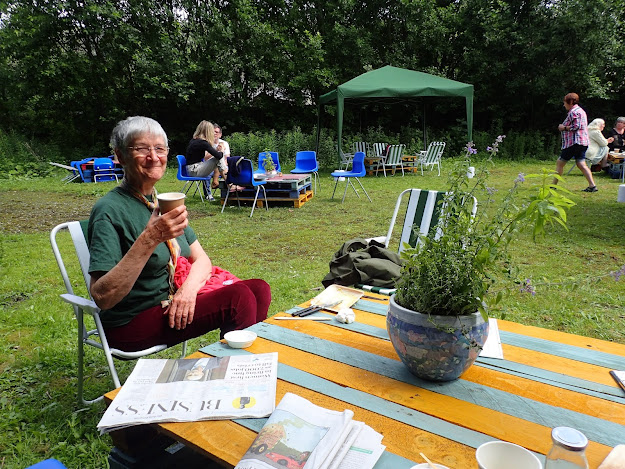Dark red-brown, marble-sized pompoms blowing in the wind. And just coming out now. I call it the Midland Railway Plant because it is the same colour as the Midland Railway - Settle Carlisle Line.
 |
| Here it is growing on a road verge
next to the Settle Carlise Line,
on the underpass leading to the Langcliffe Hoffman Kiln
|
I used to give a talk at Malham Tarn Field Centre Every year in July for the participants of the week's course that David Allison ran on "The Settle Carlisle Line and other railways." I would collect a few flowers from the roadside near the railway - including Greater Burnet. to take up and show the group. When you look under a hand-lens you can see such detail and beauty as to blow your mind away.
The pompom is made of lots of separate flowers. Each flower has 4 dark red sepals, no petals, 4 anthers and one stigma that is papillate (Has tiny lumps - papillae on it)
It likes to grow in "traditional" Hay Meadows and damp lime rich places. It gives its name to the vegetation type found on traditionally managed flood meadows such as those at the Derwent Ings. ( British NVC community MG4 Meadow Foxtail- Greater Burnet Grassland)
There would once have been lots of this vegetation in the meadows between Long Preston and Settle. Now they have been reseeded and the Greater Burnet is gone, except for odd plants on the road verge.
It would once have been more common in traditional dales hay meadows, but now the meadows are cut so promptly after the first date allowable for cutting that that plants do not get chance to shed seed, unless they are growing on a field margin.
I remember when small and travelling by car to Weardale with my parents - ritual stops were made at certain fields to collect flowers to make burnet wine. But that was over 50 years ago.
2. Salad Burnet:
Earlier in the year Greater Burnet's little sister "Salad Burnet" was in flower on several the grazed limestone slopes I walked over. The pinnate leaves are very similar to Greater Burnet, but smaller. And smell and taste of Cucumber.
The flowers are different: The top flowers in the pompom are all female - they have red
 |
| Salad Burnet on Langcliffe Brow |
Since both species have once pinnate leaves and both grow on limestone soils, how do can you tell them apart when they are not flowering?
 |
| Greater Burnet Leaves |
 |
Greater Burnet
|
 |
Salad Burnet
|
On the topic of the Settle Carlisle Line,
Why not
a) Visit the Friends of the Settle Carlisle Line Shop at Settle - where you can buy cups of tea, ice cream and gifts and cards. - normally open 10 - 3.15 daily but currently depends on volunteer availability. This is one of the 45 places within 2.6 miles of Settle where you can buy food or drinks or (some eat in, some take away)
b) Go on a trip on the Staycation Train from Skipton to Appleby and back (It does stop at Settle) - It started last week and runs three times a day.
You will see Greater Burnet on some of the banks of the trackside .
--------
Malham Tarn Field Centre 8-Aug-2013:-
Greater Burnet, Knapweed and Devil's-bit Scabious on Tarn Close the lawn at Malham Tarn Field Centre 8-Aug-2013

















































